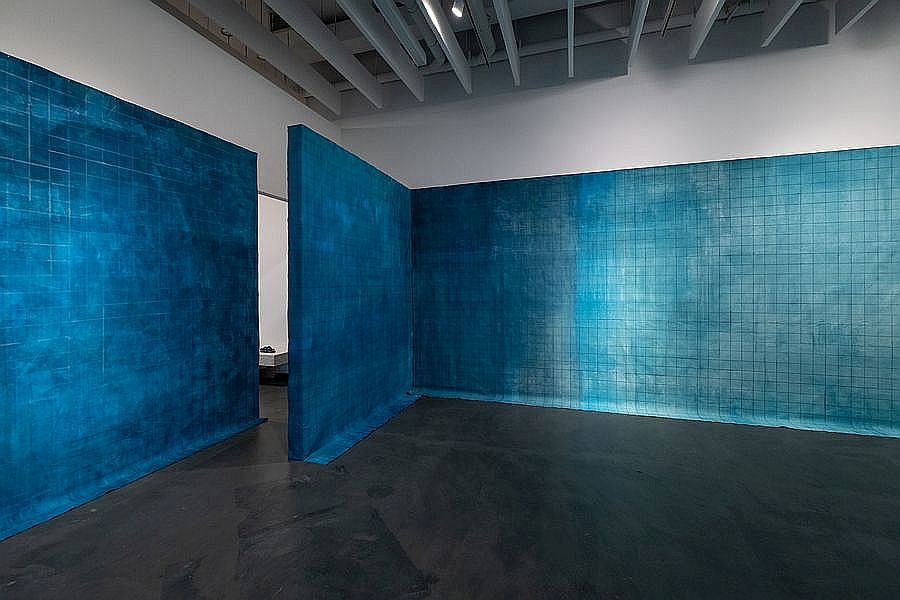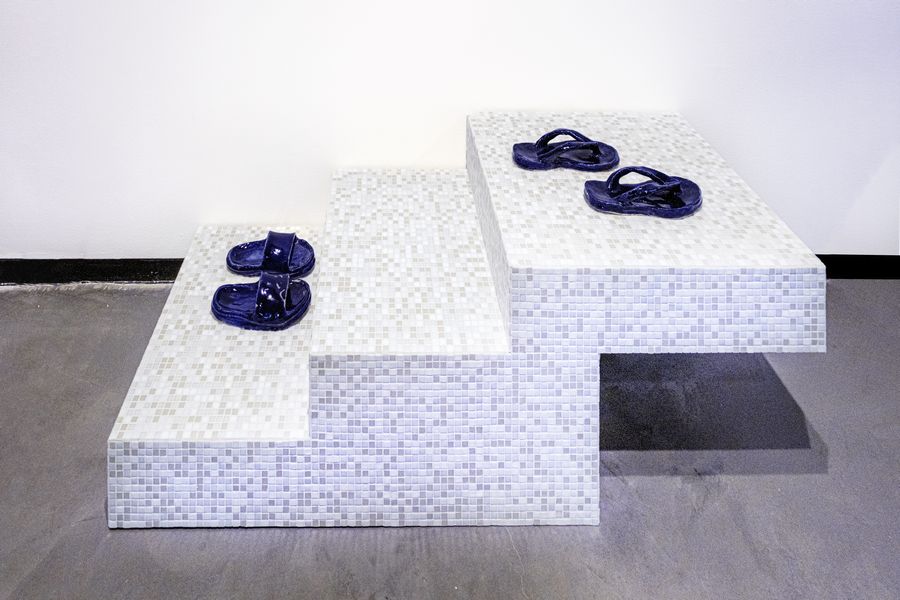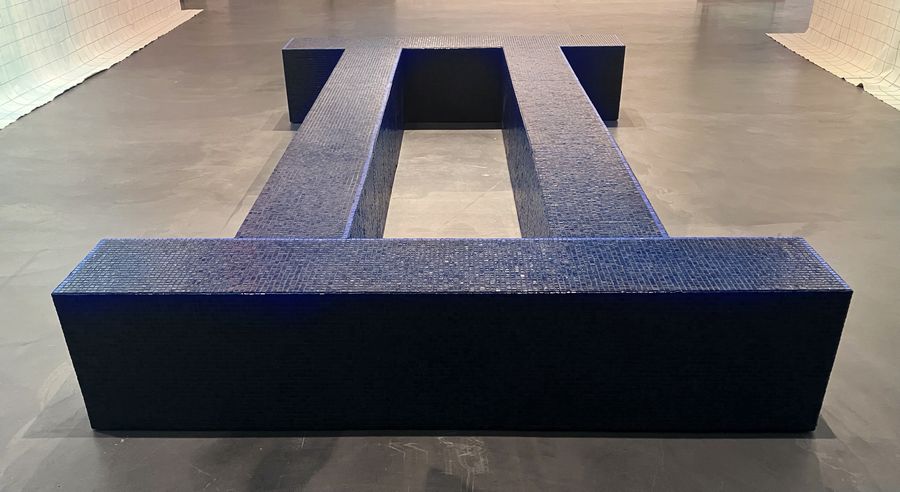
C.J. CHUECA: MERMAIDS IN THE BASEMENT
By Blanca de la Torre | Curator
Not many people know that the original mermaids were half bird, half woman. The first written source where they appear is in Homer’s Odyssey, in Book XII, where Ulysses, on his return home after the Trojan War, manages to avoid the attraction of their songs by forcing himself to be tied to the mast of his ship and the ears of his crew to be plugged with wax. The scene has been portrayed on numerous occasions in the History of Greek and Roman art through paintings, ceramics, and friezes, as well as mosaics, a technique to which we will return later.
From the multiple versions of the origin of these mythological creatures, most of them derived from patriarchal visions centered on the figure of women as being evil or envious, we will stay with the one associated with Persephone, daughter of Zeus and Demeter, and kidnapped by Hades, God from the underworld. To save her, her friends ask Zeus to give them wings to chase after the captor god.
It was in the Middle Ages when this legendary figure would change the feathers for the fishtail, whose first testimony is found in the Anglo-Latin manuscript Liber Monstruorum (S. VII–S. VIII).

The «mermaids» protagonists of C.J Chueca‘s work are women from different geographies, who sing stories that have to do with dispossession and lost land. The first of this series was recorded in Honduras, one of the three countries in the world most vulnerable to the climate emergency (the third cause of emigration, after violence and hunger), and was made on the occasion of the exhibition The Sound of Sinking Voices, at the CCE in Tegucigalpa.
The exhibition focused on the dramatic situation of Cedeño, a village in the south where the ocean advances up to 1.22 meters inland every year, devouring homes, and businesses such as that of Blanca Azucena Guevara Bonilla whose song was recorded by the artist. Along with this, the songs of a Filipino woman, a Saharawi, a Californian actress, a woman from Nashville, and another one from Mexico, Sudan, Ghana, and Peru.
The latter is marked by the artist’s family’s past in the Sierra de Jauja, the first capital of the Spanish empire, whose huaicos (very strong storms) overflowed the river basins, devastating the territory, which is why her family was forced to abandon that place.


According to the legend, after Ulysses (also called Odysseus) and the sailors who accompanied the hero did not succumb to the hypnotic intonations, the sirens lost their gift of singing and rushed into the sea, yet another story of loss and uprooting, of a migrant mermaid and forced abandonment.
The idea of a singing siren, reinforced by the notion of a birdwoman, is also fused here with the fish-shaped version common in collective and popular imaginary. However, the image of the mermaid is avoided in the exhibition, thus reinforcing the suggestive power of the empty space, the fabulation around water, and the melancholic women’s song to lost memories.
The mosaic technique takes center stage in the exhibition, whose origins can be found in ancient Greece (although the way we know it today, was later developed during the Roman Empire), with numerous examples found in archaeological sites of the Hellenistic era. Around half of these tessellated Greek mosaics come from Delos, one of the Cyclades Islands, where we can also find marine motifs, mythological beings, and wave patterns, a very common motif at that time.
The word mosaic comes from the Latin musivus -a -um, whose origin is in the Greek mouseion (μoυσειoν), concerning the muses (μoυσα-ης), because for the Romans the mosaic art was so exceptional that it could only be created either by those inspired by the muses or by these same divinities themselves.
For the preparation of these techniques, some fabric or papyrus templates were made on which the grids and drawings were drawn, which refer us to the canvases that cover the walls here.
In Chueca’s room, she has painted them like tiles, as a woven wallpaper that protects the room, but which in turn refers to those of a pool of any place or non-place, to the solitude of the bathroom.


The exhibition’s title is taken from an Emily Dickinson poem (I started early, – Took my dog, visited the sea, – The Mermaids in the Basement – Came out to look at me), an American poet who explored aesthetics, spirituality, and nature from her own “basement” (making a nod here to Virginia Wolf‘s seminal book A Room of One’s Own, and to all those unheard sirens of the History of Art and Culture). It also suggests a displacement from a natural place (the sea or any of our own ecosystems) to an urban environment (basement).
The various works that comprise the exhibition are located in this metaphorical space created by the artist, intertwining like a great immersive installation and taking their titles from poems concerning water.
The Water Understands, the first line from a verse by Waldo Emerson (The water understands – Civilization well – It wets my foot, but pretty – It chills my life, but wittily) gives the title to a sculpture consisting of two flip-flops resting on a pool ladder, together with another pair that the spectator finds abandoned in the back of the room.
Inevitably, the connection with water appears also as the main ingredient of the ceramic technique with which they have been made, but they also refer to the abandoned footwear of the refugees and once again connect the natural space, on this occasion the beach, with the urban and the artificiality of the pool that is evoked.
The second would be the canvases of the walls themselves, which bring us back to Dickinson: Water, is Taught by Thirst (Water, is taught by thirst-Land – by the Oceans passed – Transport – by throe — Peace – by its battles told – Love, by Memorial Mold – Birds, by the Snow).

Ceramic tiled walls have been a constant in the work of C.J. Chueca, always paying homage to the dispossessed, marginalized, and excluded. As Eleanor Heartney points out, “she loves it for its fragility and stoic endurance and embraces its connection to the troubled lives that it has failed to shelter.”
For this author, the artist’s walls have a typical quality that in this instance also evokes the gesture of looking at the pool’s walls and roof while swimming, submerging, or floating in the water. Like the feeling of returning to the mother’s womb, the metaphor of the possibility of a return, and longing for the land where we came from. In addition, the decision that the dimensions of the painted tiles correspond to those that cover the New York subway stations seeks a sense of disturbing familiarity with the daily life of the city.
Like the ceramics created for this exhibition, the thousands of square pieces drawn here are handmade, line by line, in sequences that go from day to night and night to day. For them, she has used pigments from her native country, such as Peruvian turquoise.
This importance given to artisan processes is another way of addressing these other losses of collective memory, of vindicating those other epistemologies that have been relegated, reviled, or banished by those hegemonic ones typical of biocapitalism.

Another classical poet, William Butler Yeats, gives the title to the structure located in the center of the room: To an Isle in the Water (And shy as a rabbit – Helpful and shy – To an isle in the water – With her would I fly). The double H-shaped sculpture is built with two lines of an Olympic pool put together and configured as an island.
Chueca has conceived the size so that any person can fit inside with arms and legs stretched out, to allude to the body as an island and, once again, to that idea of body-territory. From the work emerges the sound of the aforementioned work: All Day I Hear the Noise of Waters, which leads us to James Joyce (All day I hear the noise of waters – Making moan – Sad as the seabird is when, going – Forth alone – He hears the winds cry to the water’s – Monotone).
In it, our mermaids-muses sing to the memory of the bodies-territory, of the pain or sorrow that accompanies displacement, and of the memories that were left behind.

As we mentioned in the case of the Honduran village’s climatic displacements, the Philippine song transports us to an island that has been hard hit in recent years by extreme weather events caused by the ecological emergency.
The same feeling arises in the cases of the intonations of the indigenous women since the First Nation communities are the ones who have been living in “sacrifice zones” and suffering the most from dispossession and forced displacements due to extractivist policies, with water basins as the main agencies of impact.
Some of the songs, sung by the women included by Chueca, come from popular orality, accounting for the recovery of ancestral cosmogonies and knowledge. The decolonial component is also glimpsed with the use of the tiles, which remain in the collective imagination as part of the colonial heritage of the Abya Yala territories (Latin America) and which inevitably suggest a review of the role of colonialism in the ecological emergency and the idea of climate debt to countries of the Global South.
The climate crisis is a story about oppressive systems and an unbalanced scale of environmental justice. Water is poetry as well as politics. Chueca transports us to a metaphorical space where the speculative is traversed by a moment when the UN has just announced the impossibility of saving the glaciers in the future.
They, like our hopes for a decarbonized tomorrow, will dwindle day by day. We need to join forces and build a new territory for the commons from all fronts and disciplines now more than ever to construct a valid narrative of repair, resilience, and transformation.

C.J Chueca’s Mermaids in The Basement is on view until August 20, 2023, at Sugar Hill Children’s Museum of Art and Storytelling, 898 St. Nicholas Ave., New York, NY.
También te puede interesar
Mundos Alternos:art And Science Fiction in The Americas
"Mundos Alternos: Art and Science Fiction in the Americas" brings together the work of 30 international artists from across Latin America and the Caribbean, including Mexico, Cuba, Argentina, El Salvador, Brazil, Chile and Puerto...
JOHANNA UNZUETA: NATURALIST
In "Naturalist", Johanna Unzueta's (b. 1974, Santiago, Chile) first solo exhibition at Casey Kaplan, the artist draws from the natural world and the balance between the earth and its living counterparts. In an intimate exploration...
EL HORROR Y LA PATRIA
La violencia, entendida como una zona de emisiones, es el eje articulador de la muestra "Metal y Melancolía", de Magdalena Quijano, donde las posibilidades y limitaciones de la visión se acentúan por efecto del...



